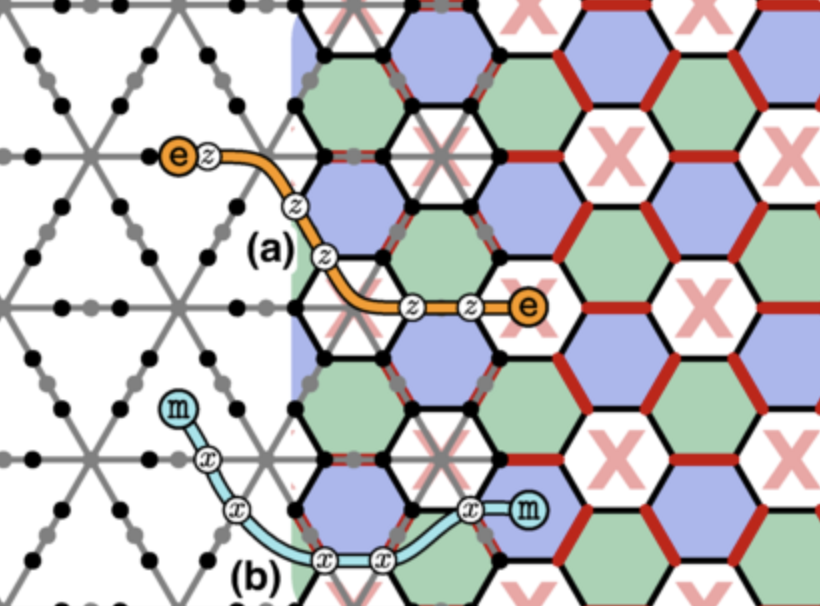Researchers have developed a theory of topological quantum computing using anyon condensation, a type of topological phase transition, to perform fault-tolerant logical operations. Using the color-code model, they demonstrated that different condensation processes are associated with a general class of domain walls. The color code, a topological quantum error-correcting code, offers a rich structure for topological quantum computing. The researchers’ work provides a new perspective on manipulating topologically ordered phases of matter for quantum information processing, potentially leading to more efficient and reliable quantum computing architectures.
What is Anyon Condensation, and How Does it Relate to Quantum Computing?
Quantum computing is a rapidly evolving field that leverages the principles of quantum mechanics to process information. One key concept in this field is the manipulation of topologically ordered phases of matter to encode and process quantum information. This forms the cornerstone of many approaches to fault-tolerant quantum computing. In a recent study, researchers have demonstrated that fault-tolerant logical operations in these approaches can be interpreted as instances of anyon condensation.
Anyon condensation is a special type of topological phase transition. It involves identifying a subset of anyons (quasi-particles that exist only in two dimensions) of the phase with the vacuum particle of a condensate. The researchers developed a constructive theory for anyon condensation and illustrated it explicitly using the color-code model. They showed that different condensation processes are associated with a general class of domain walls, which can exist in both space-like and time-like directions. This class includes semi-transparent domain walls that condense certain subsets of anyons.
How Does Anyon Condensation Contribute to Quantum Computing?
The researchers used their theory to classify topological objects and design novel fault-tolerant logic gates for the color code. They argued that dynamical Floquet codes can be viewed as a series of condensation operations. They proposed a general construction for realizing planar dynamically driven codes based on condensation operations on the color code. They introduced a new Calderbank-Shor-Steane-type Floquet code called the Floquet color code.
The color code is a topological quantum error-correcting code with a rich structure that can be harnessed for topological quantum computing. Its study was first motivated by its multitude of available transversal logic gates. In addition to these local constant-depth unitary logical operations, which are inherently fault-tolerant, the color code can also demonstrate various fault-tolerant measurement-based code deformations. These operations can be combined to give universal low-overhead fault-tolerant quantum computing with favorable resource requirements over those of the surface code.
What is the Significance of the Color Code in Quantum Computing?
The versatility of the color code for performing fault-tolerant logic gates can be attributed to the underlying symmetries among its quasiparticle excitations when viewed as a topological model. Furthermore, the color code can be decomposed into copies of more elementary phases. These properties mean that the color code offers an excellent test bed for designing practical ways of performing fault-tolerant quantum computation and investigating the fundamental phenomena of topological phases that enable robust logical operations.
The researchers developed a theory of topological quantum computing in terms of anyon condensation for stabilizer codes, using the color code as a guiding example. They found that anyon condensation offers a natural way of describing many aspects of quantum computation with topological stabilizer codes. It offers a concise and unified language for the logical operations in the color code and other code-deformation and code-switching schemes.
How Does Anyon Condensation Work in Practice?
The researchers implemented anyon condensation in the color code in various ways. As a first example, they considered condensing the anyons in a disk-shaped region of the color-code lattice. This allowed them to recover the punctures with different types of boundaries discovered earlier in the literature. The boundaries that they produced can be viewed as a non-local degree of freedom, the state of which is determined by the type of anyons it has condensed through local processes.
Punctures provide the standard mechanism to encode quantum information in a topological code. Given these properties, the researchers could interpret the punctures as logical qubits that can be manipulated to perform quantum computations. This is a significant step forward in the field of quantum computing, as it provides a new way to perform fault-tolerant logical operations.
What are the Implications of this Research?
This research has significant implications for the field of quantum computing. It provides a new perspective on manipulating topologically ordered phases of matter to encode and process quantum information. It also offers a novel method for implementing robust operations that are available with topological phases, which could lead to more practical ways of performing the logical operations needed for universal fault-tolerant quantum computing.
The researchers’ work on anyon condensation and the color code model contributes to the understanding of topological quantum error-correcting codes and the design of fault-tolerant logic gates. It also opens up new avenues for research into the fundamental phenomena of topological phases that enable robust logical operations. This could ultimately lead to the development of more efficient and reliable quantum computing architectures.
Publication details: “Anyon Condensation and the Color Code”
Publication Date: 2024-03-11
Authors: Markus S. Kesselring, Julio C. Magdalena de la Fuente, Felix Thomsen, Jens Eisert, et al.
Source: PRX Quantum 5, 010342
DOI: https://doi.org/10.1103/PRXQuantum.5.010342

